Cuba Street, Wellington
Cuba Street is a prominent city street in Wellington, New Zealand, and has been widely called the centre of the city's unique culture. The street, internationally famed for its "bohemian nature" and compact amount of culture, the street boasts scores of many cafés, venues, shops, restaurants, record shops, bookshops, heritage architecture of various styles, and a general "quirkiness"[1] that has made it one of the city's most popular tourist destinations.[2][3]
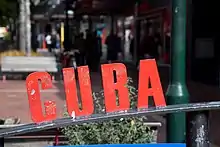
Its history is one of the most notable of all of Wellington's streets. Developed at the point of colonisation, Cuba Street runs south from the CBD of Wellington in the inner city, and was originally full of huts and very basic homes built into the forest, such as "the Old Shebang".[4] Contrary to colloquial assumption that the street is named after Cuba, it is actually named after an early New Zealand Company settler ship, the Cuba, which arrived in Wellington Harbour on 3 January 1840; many coffeeshops and restaurants take this misinterpretation in their stride, having names and colours that reference the island.[5][6] Cuba Street runs across land that was once next to Te Aro Pā[7] and gardens of Māori iwi who lived there.[8] The street's historic buildings, spanning Edwardian, Art Deco, and various weatherboard styles, were completed from the 19th-20th centuries. From the 1970s to early 80s, the street became the red light district of Wellington, and a sign of solidarity against the severe anti-male homosexuality laws New Zealand had until 1986. The street's rainbow crossing and icons of local drag queen and activist Carmen Rupe commemorate this.[9]
The section between Dixon Street and Ghuznee Street is a pedestrian mall, with bustling streets filled with shops further up.[10] The area is divided into distinct parts; Lower, Central and Upper Cuba, which have different architecture and are fairly distinct, as well as Lower Cuba being more pedestrian. Part of the large inner city suburb of Te Aro, Cuba Street has become increasingly the home of Wellington's culture since the 1960s, and has been called the city's "creative heart".[11]
History and location
Cuba Street runs south from the CBD of Wellington in the inner city. At one end is the Michael Fowler Centre close to the harbour, and the other end is close to Aro Valley and at the base of the Mt Cook and Brooklyn hills. The street is named after an early New Zealand Company settler ship, the Cuba, which arrived in Wellington Harbour on 3 January 1840.[5] Cuba Street runs across land that was once next to Te Aro Pā[7] and gardens of Māori iwi who lived there.[8]
One of the first colonial families that purchased land around upper Cuba Street were the Tonks in the 1840s. They established brickyards, and streets in the area were named after them including Tonks Ave, Arthur Street, and Frederick Street.[5] Cuba Street was a major thoroughfare in this time. It was sealed in the late 1800s and got gas street lamps in 1860s.[12] The historic area of upper Cuba Street near Tonks Ave and Arthur Street was majorly re-formed due to a controversial inner city bypass road that was completed in 2007.[13]
For 60 years Cuba Street was an electric tram line (1904–1964) as part of the Wellington tramway system. After the tramlines were removed and following public pressure the middle section of the street closed to traffic in 1969 to become a pedestrian mall and has remained so.[5]
Since 1995 Cuba Street has been a registered Historic Area under the Historic Places Act 1993, with over 40 buildings of historic significance[14][5] including the Bank of New Zealand building. Despite the number of older buildings in the street, there was little building damage from the 2016 Kaikoura earthquake.[15]
Cuba Street is the centre of one of the four 'quarters' of downtown Wellington, the Cuba Quarter, the other quarters are centred on Lambton Quay, Courtenay Place and Willis Street.
Literary history
Mary Taylor (1817–1893), lifelong friend and correspondent of author Charlotte Brontë owned and ran a small Cuba Street general store, from circa 1840 to 1860. The shop no longer exists but a heritage storyboard at the intersection of Cuba and Dixon streets commemorates her.[16]
Local people and activities
Cuba Street is described as the bohemian creative area of Wellington, and is the home to many cafes, op-shops, boutique fashion stores, art galleries, and music shops.[17]
On Cuba Street is the Enjoy Gallery, {Suite} Gallery, McLeavey Gallery, and Thistle Hall. In 2005, the new Wellington Arts Centre was established in Abel Smith Street, a half block from upper Cuba Street. Also nearby are Victoria University of Wellington Faculty of Architecture and Design, Access Radio, Radio Active, Glover Park. Glover Park was a regular hangout of rough sleepers and a council Public Places Bylaw that was reviewed in 2004 meant they were getting evicted which essentially moved them into Cuba Mall.[18]
The Bucket Fountain is a prominent sculpture in Cuba Mall.
In 2018 some retailers moved into the adjacent Ghuznee Street.[19]
The northern end is more commercial, with established chain stores such as Whitcoulls and The Body Shop. The southern end (known as the 'top' of Cuba Street, or upper Cuba) is more boutique.
In the mid 1970s to early 80s, Vivian Street which crosses Cuba St was Wellington's red light district, with street prostitutes strip clubs, peep shows and gay bars. New Zealand's first iconic drag queen and activist Carmen Rupe ran Carmen's International Coffee Lounge on Vivian Street in the 60s and 70s.[20][21] Pedestrian light signals in her likeness were put up in four intersections along Cuba Street in 2016 to coincide with the 30-year anniversary of the Homosexual Law Reform Bill coming into effect.[22]
Music and venues
Cuba Dupa is an annual street party celebrating Cuba Street.[23]
Fat Freddy's Drop's first album, Live at the Matterhorn was recorded at the Matterhorn bar on Cuba Street. Other venues in the area include Hotel Bristol, San Francisco Bathhouse, J.J. Murphy's, Southern Cross, S&M Bar, Midnight Espresso, Olive, K Bar, Hope Brothers, Havana Bar, Good Luck, The Duke, and Logan Brown. The lower end of Cuba Street ends at Wellington Town Hall, Civic Square, Michael Fowler Centre, and Wakefield Street.
Gallery
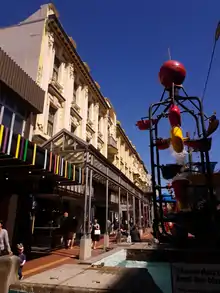 The Bucket Fountain, Cuba Street, Wellington, November 2020
The Bucket Fountain, Cuba Street, Wellington, November 2020 Upper Central Cuba Street at night
Upper Central Cuba Street at night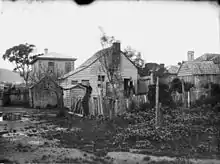 Bachelor cottage "The Old Shebang" near Tonks Ave on Cuba Street ca 1883
Bachelor cottage "The Old Shebang" near Tonks Ave on Cuba Street ca 1883 Wellington City – Streets Publicity Caption Wellington City Views. Cuba Street Shopping Mall Photographer G Hutchinson
Wellington City – Streets Publicity Caption Wellington City Views. Cuba Street Shopping Mall Photographer G Hutchinson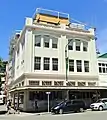 Earthquake strenthening taking place – Cuba St
Earthquake strenthening taking place – Cuba St Cuba St.looking north from Ghuznee Street in summer
Cuba St.looking north from Ghuznee Street in summer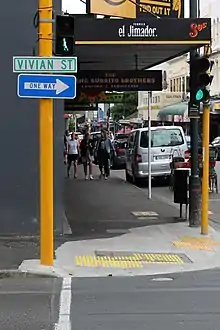 Carmen Rupe pedestrian crossing light at the Vivian and Cuba Street intersection
Carmen Rupe pedestrian crossing light at the Vivian and Cuba Street intersection Performance at venue San Francisco Bathhouse by Canadian artist Peaches (musician)
Performance at venue San Francisco Bathhouse by Canadian artist Peaches (musician)
References
- "Cuba Street". www.wellingtonnz.com. Retrieved 22 November 2020.
- "Cuba Street". screenwellington.com. Retrieved 22 November 2020.
- "48 hours in Wellington, New Zealand: where to go, what to do". the Guardian. 30 November 2015. Retrieved 22 November 2020.
- Williams, William (1 January 1883). ""The Old Shebang", Cuba Street, Wellington". "The Old Shebang", Cuba Street, Welli... | Items | National Library of New Zealand | National Library of New Zealand. Retrieved 22 November 2020.
- "Cuba Street has time on its side". Wellington City Council. 13 March 2015. Retrieved 22 August 2020.
- "Cuba St's revolutionary cafe: Fidel's". www.wellingtonnz.com. Retrieved 22 November 2020.
- "Te Aro Pa – Map C.1. No 2". Wellington City Libraries Te Matapihi ki te Ao Nui. Retrieved 22 August 2020.
- "Te Aro pa and Matairangi". Wellington City Libraries Te Mataphi ki te Ao Nui. Retrieved 22 August 2020.
- "Pride in new rainbow crossing on Wellington's Cuba street". RNZ. 9 October 2018. Retrieved 22 November 2020.
- Alves, Thalita (8 June 2017). "A Brief History of Cuba Street, Wellington". Culture Trip. Retrieved 1 February 2020.
- "Cuba Street". screenwellington.com. Retrieved 22 November 2020.
- Gunter-Firth, Fiona (13 February 2013). "A Photographic history of Cuba Street". Cuba St Project. Retrieved 22 August 2020.
- O'Neil, Andrea (5 April 2015). "150 years of news: Protests against inner-city bypass exposed deep rift in Te Aro district heritage". Stuff. Retrieved 22 August 2020.
- "Cuba Street Historic Area". Register of Historic Places. Heritage New Zealand. Retrieved 1 December 2009.
- "Miracle on Cuba Street". Stuff (Fairfax Media). 21 November 2016.
- "Mary Taylor, friend of Charlotte Bronte – The Cuba Street Memories Project". Kete.wcl.govt.nz. Retrieved 29 February 2016.
- "Cuba Street". Screen Wellington. Retrieved 22 August 2020.
- "Eviction 'forces' Wellington homeless into city centre". NZ Herald. 20 April 2004. ISSN 1170-0777. Retrieved 22 August 2020.
- "Business exodus from Cuba Street is Ghuznee's gain as new precinct thrives". Stuff (Fairfax). 2 May 2018.
- "Queer nightlife in Wellington". Collections Online Museum of New Zealand Te Papa Tongarewa. Retrieved 22 August 2020.
- McBride, Kerry (26 March 2012). "Teacups talked at Carmen's coffee lounge". Stuff. Retrieved 22 August 2020.
- Nicoll, Jack (8 August 2016). "Carmen Rupe lighting up Wellington streets once again". Stuff. Retrieved 22 August 2020.
- "CubaDupa – 24th and 25th March 2018". www.cubadupa.co.nz. Retrieved 10 October 2018.
External links
| Wikimedia Commons has media related to Cuba Street, Wellington. |
{coord|-41.291747|174.776562|region:NZ-WGN_type:landmark|display=title}}